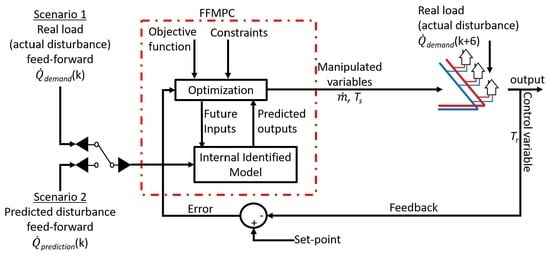Achieving Lower District Heating Network Temperatures Using Feed-Forward MPC
Abstract
:1. Introduction
2. State of the Art-Background
2.1. Modelling
2.2. Control
2.3. Motivation and Contributions
- What are the potential energy savings from implementing feed-forward model predictive control in district heating networks?
- To what level of certainty is required, in regards to feed-forward signals, in order to reduce the supply and return temperatures in a district heating network?
3. Method
3.1. Description of the District Heating Network
3.2. Physical Model
3.3. Model Predictive Control
3.4. Overview of Prediction Model
4. Results and Discussion
4.1. Validation
4.2. Control Implementation
4.3. Control Performance and Assessment
5. Conclusions
Author Contributions
Funding
Acknowledgments
Conflicts of Interest
References
- Werner, S. International review of district heating and cooling. Energy 2017, 137, 617–631. [Google Scholar] [CrossRef]
- Averfalk, H.; Werner, S. Novel low temperature heat distribution technology. Energy 2018, 145, 526–539. [Google Scholar] [CrossRef]
- Nord, N.; Schmidt, D.; Kallert, A.; Svendsen, S. Improved Interfaces for Enabling Integration of Low Temperature and Distributed Heat Sources—Requirements and Examples. In Proceedings of the CLIMA 2016—Proceedings of the 12th REHVA World Congress, Aalborg, Denmark, 22–25 May 2016. [Google Scholar]
- Gadd, H.; Werner, S. Fault detection in district heating substations. Appl. Energy 2015, 157, 51–59. [Google Scholar] [CrossRef] [Green Version]
- Flores, J.F.; Lacarrière, B.; Chiu, J.N.; Martin, V. Assessing the techno-economic impact of low-temperature subnets in conventional district heating networks. Energy Procedia 2017, 116, 260–272. [Google Scholar] [CrossRef]
- Nord, N.; Løve Nielsen, E.K.; Kauko, H.; Tereshchenko, T. Challenges and potentials for low-temperature district heating implementation in Norway. Energy 2018, 151, 889–902. [Google Scholar] [CrossRef]
- Schmidt, D.; Kallert, A.; Blesl, M.; Svendsen, S.; Li, H.; Nord, N.; Sipilä, K. Low Temperature District Heating for Future Energy Systems. Energy Procedia 2018, 149, 595–604. [Google Scholar] [CrossRef]
- Lund, H.; Werner, S.; Wiltshire, R.; Svendsen, S.; Thorsen, J.E.; Hvelplund, F.; Mathiesen, B.V. 4th Generation District Heating (4GDH). Integrating smart thermal grids into future sustainable energy systems. Energy 2014, 68, 1–11. [Google Scholar] [CrossRef]
- Gadd, H.; Werner, S. Achieving low return temperatures from district heating substations. Appl. Energy 2014, 136, 59–67. [Google Scholar] [CrossRef] [Green Version]
- Gabrielaitiene, I.; Bøhm, B.; Sunden, B. Modelling temperature dynamics of a district heating system in Naestved, Denmark—A case study. Energy Convers. Manag. 2007, 48, 78–86. [Google Scholar] [CrossRef]
- Giraud, L.; Baviere, R.; Vallée, M.; Paulus, C. Presentation, Validation and Application of the DistrictHeating Modelica Library. In Proceedings of the 11th Modelica Conference, Versailles, France, 21–23 September 2015; pp. 79–88. [Google Scholar] [CrossRef]
- Soons, F.; Torrens Galdiz, J.; Hensen, J.; Schrevel, R. A Modelica based computational model for evaluating a renewable district heating system. In Proceedings of the 9th International Conference on System Simulation in Buildings, Liege, Belgium, 10–12 December 2014; pp. 1–16. [Google Scholar]
- Hermansson, K.; Kos, C.; Starfelt, F.; Kyprianidis, K.; Lindberg, C.F.; Zimmerman, N. An Automated Approach to Building and Simulating Dynamic District Heating Networks. IFAC-PapersOnLine 2018, 51, 855–860. [Google Scholar] [CrossRef]
- Schweiger, G.; Larsson, P.O.; Magnusson, F.; Lauenburg, P.; Velut, S. District heating and cooling systems—Framework for Modelica-based simulation and dynamic optimization. Energy 2017, 137, 566–578. [Google Scholar] [CrossRef]
- Kauko, H.; Kvalsvik, K.H.; Rohde, D.; Nord, N.; Utne, Å. Dynamic modeling of local district heating grids with prosumers: A case study for Norway. Energy 2018, 151, 261–271. [Google Scholar] [CrossRef]
- Laakkonen, L.; Korpela, T.; Kaivosoja, J.; Vilkko, M.; Majanne, Y.; Nurmoranta, M. Predictive Supply Temperature Optimization of District Heating Networks Using Delay Distributions. Energy Procedia 2017, 116, 297–309. [Google Scholar] [CrossRef]
- Sandou, G.; Font, S.; Tebbani, S.; Hiret, A.; Mondon, C. Predictive Control of a Complex District Heating Network Qk. In Proceedings of the 44th IEEE Conference on Decision and Control, and the European Control Conference 2005, Seville, Spain, 12–15 December 2005; pp. 7372–7377. [Google Scholar]
- Grosswindhager, S.; Kozek, M.; Voigt, A.; Haffner, L. Fuzzy predictive control of district heating network. Int. J. Model. Identif. Control 2012, 19, 161. [Google Scholar] [CrossRef]
- Vandermeulen, A.; van der Heijde, B.; Helsen, L. Controlling district heating and cooling networks to unlock flexibility: A review. Energy 2018, 151, 103–115. [Google Scholar] [CrossRef]
- Saarinen, L. Modelling and Control of a District Heating System. Master’s Thesis, Department of Infomration Technology, Uppsala Univeristy, Uppsala, Sweden, 2008. [Google Scholar]
- Verrilli, F.; Srinivasan, S.; Gambino, G.; Canelli, M.; Himanka, M.; Del Vecchio, C.; Sasso, M.; Glielmo, L. Model Predictive Control-Based Optimal Operations of District Heating System With Thermal Energy Storage and Flexible Loads. IEEE Trans. Autom. Sci. Eng. 2017, 14, 547–557. [Google Scholar] [CrossRef]
- Cadau, N.; Lorenzi, A.D.; Gambarotta, A.; Morini, M.; Saletti, C. A Model-in-the-Loop application of a Predictive Controller to a District Heating system. Energy Procedia 2018, 148, 352–359. [Google Scholar] [CrossRef]
- Giraud, L.; Merabet, M.; Baviere, R.; Vallée, M. Optimal Control of District Heating Systems using Dynamic Simulation and Mixed Integer Linear Programming. In Proceedings of the 12th International Modelica Conference, Prague, Czech Republic, 15–17 May 2017; pp. 141–150. [Google Scholar] [CrossRef]
- Dalla Rosa, A.; Li, H.; Svendsen, S. Method for optimal design of pipes for low-energy district heating, with focus on heat losses. Energy 2011, 36, 2407–2418. [Google Scholar] [CrossRef]
- Torío, H.; Schmidt, D. Development of system concepts for improving the performance of a waste heat district heating network with exergy analysis. Energy Build. 2010, 42, 1601–1609. [Google Scholar] [CrossRef]
- Statistics Sweden (SCB). Population and Land Area within Localities, by Locality. Every Fifth Year 1960–2018. 2018. Available online: http://www.statistikdatabasen.scb.se/pxweb/en/ssd/START__MI__MI0810__MI0810A/LandarealTatort/ (accessed on 1 August 2019).
- Yliniemi, K. Fault Detection in District Heating Substations. Licentiate Thesis, Department of Computer Science and Electrical Engineering, Lueå University of Technology, Lueå, Sweden, 2005. [Google Scholar]
- Kozak, S. State-of-the-art in control engineering. J. Electr. Syst. Inf. Technol. 2014, 1, 1–9. [Google Scholar] [CrossRef] [Green Version]
- Frederiksen, S.; Werner, S. District Heating and Cooling; Studentlitteratur AB: Lund, Sweden, 2013. [Google Scholar]
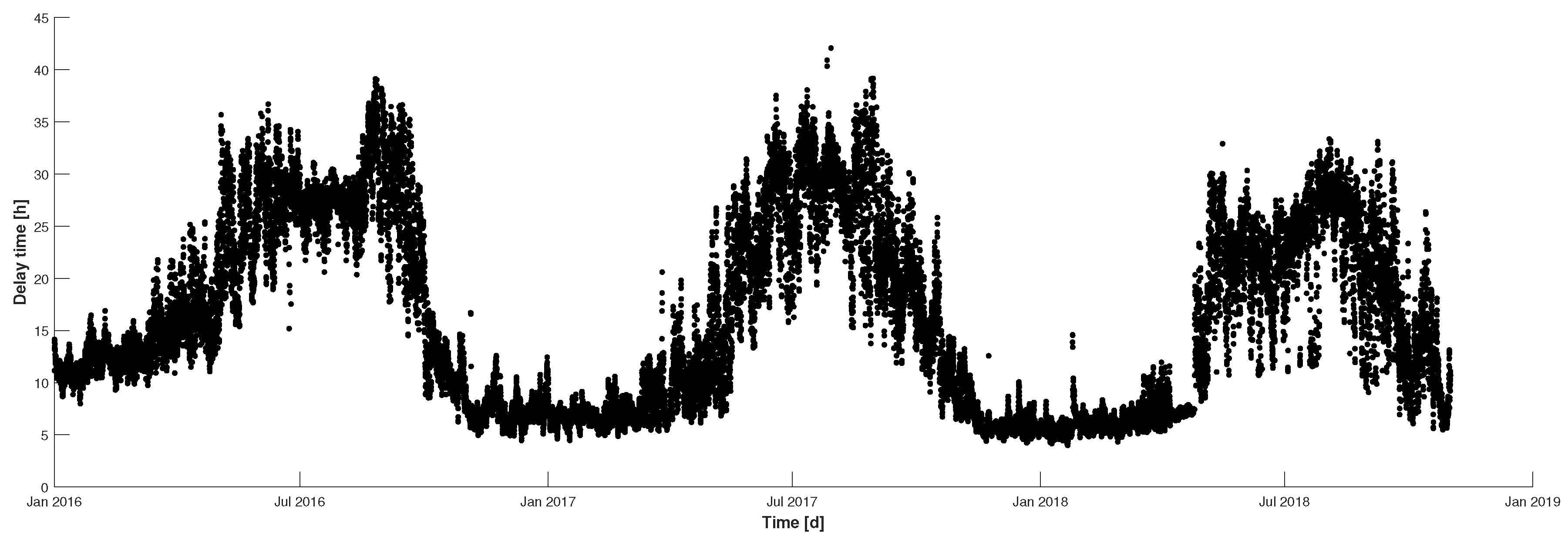
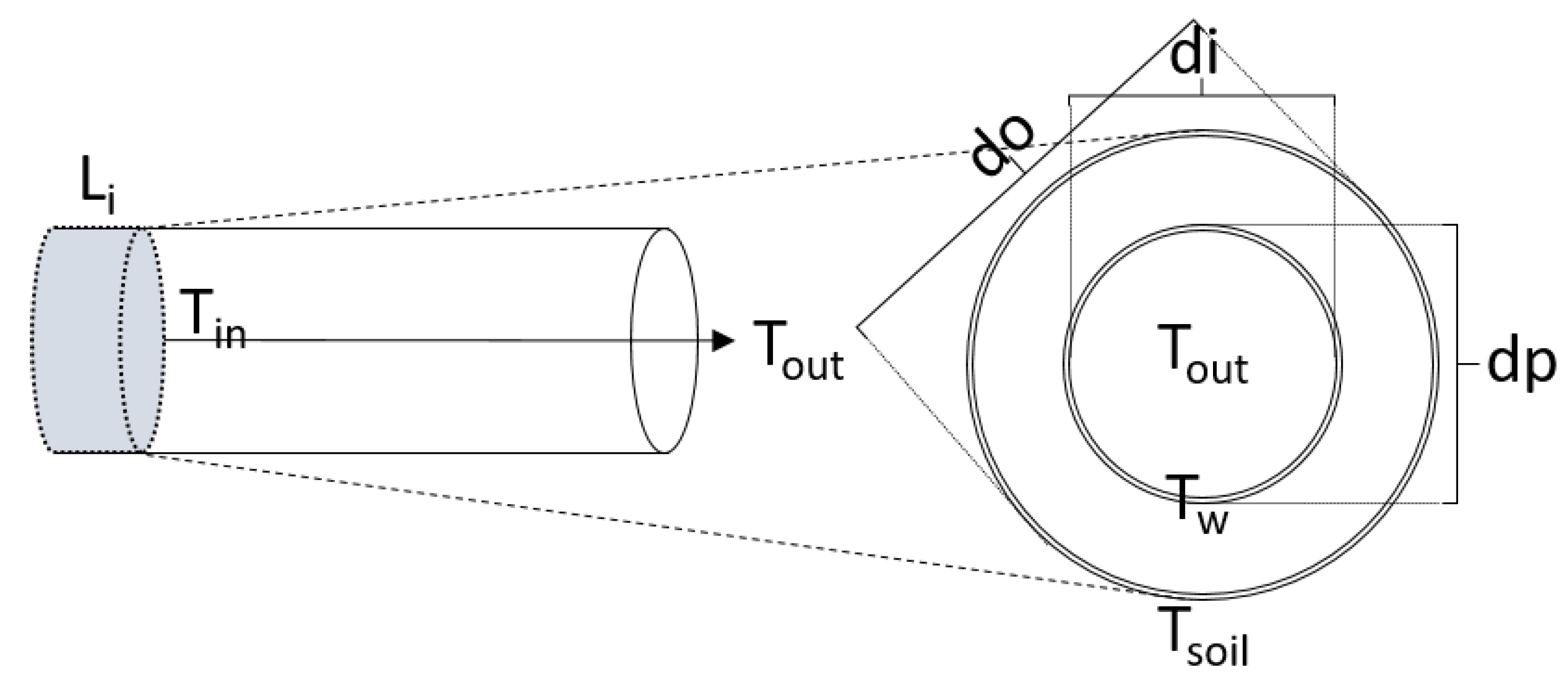
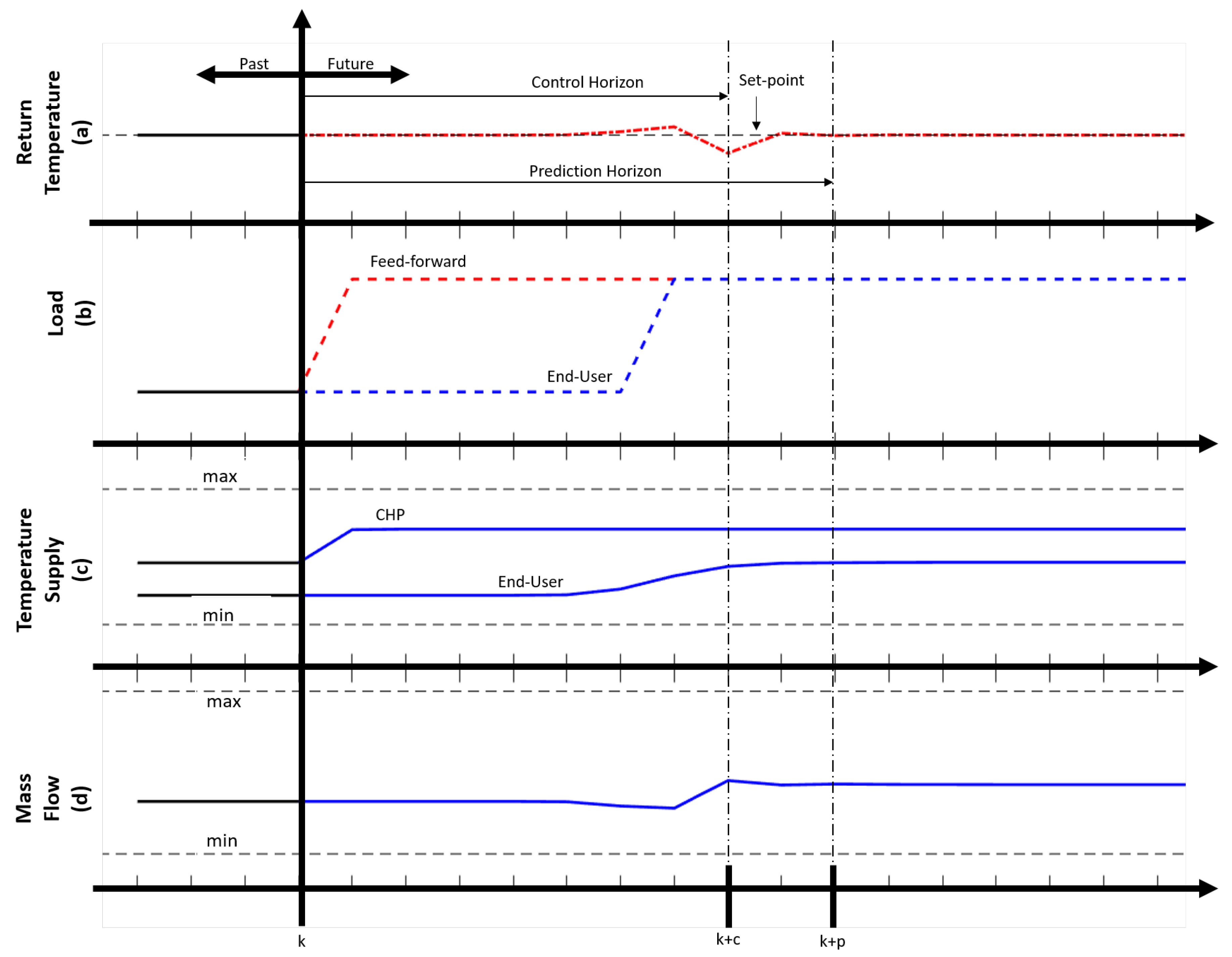
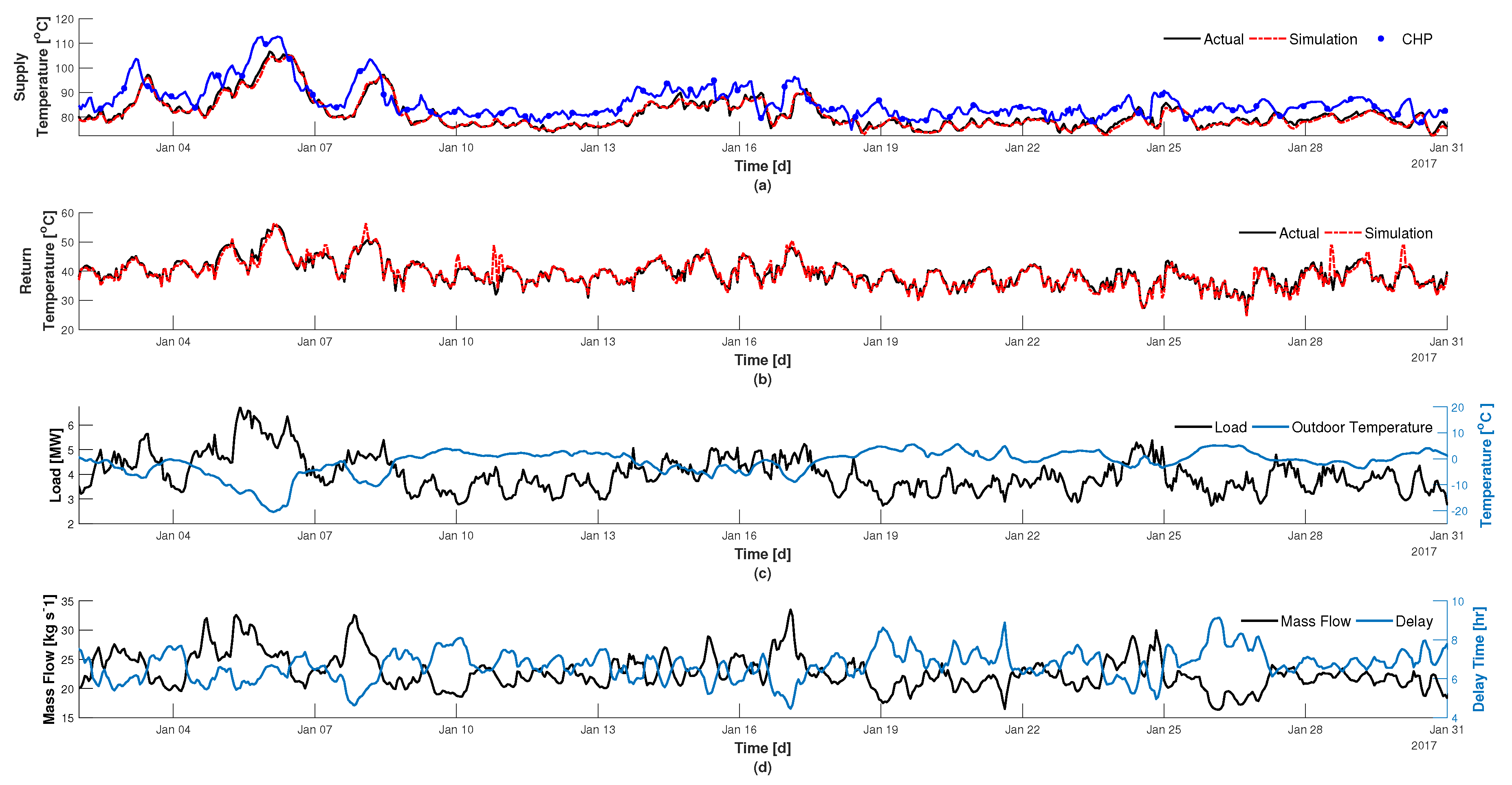
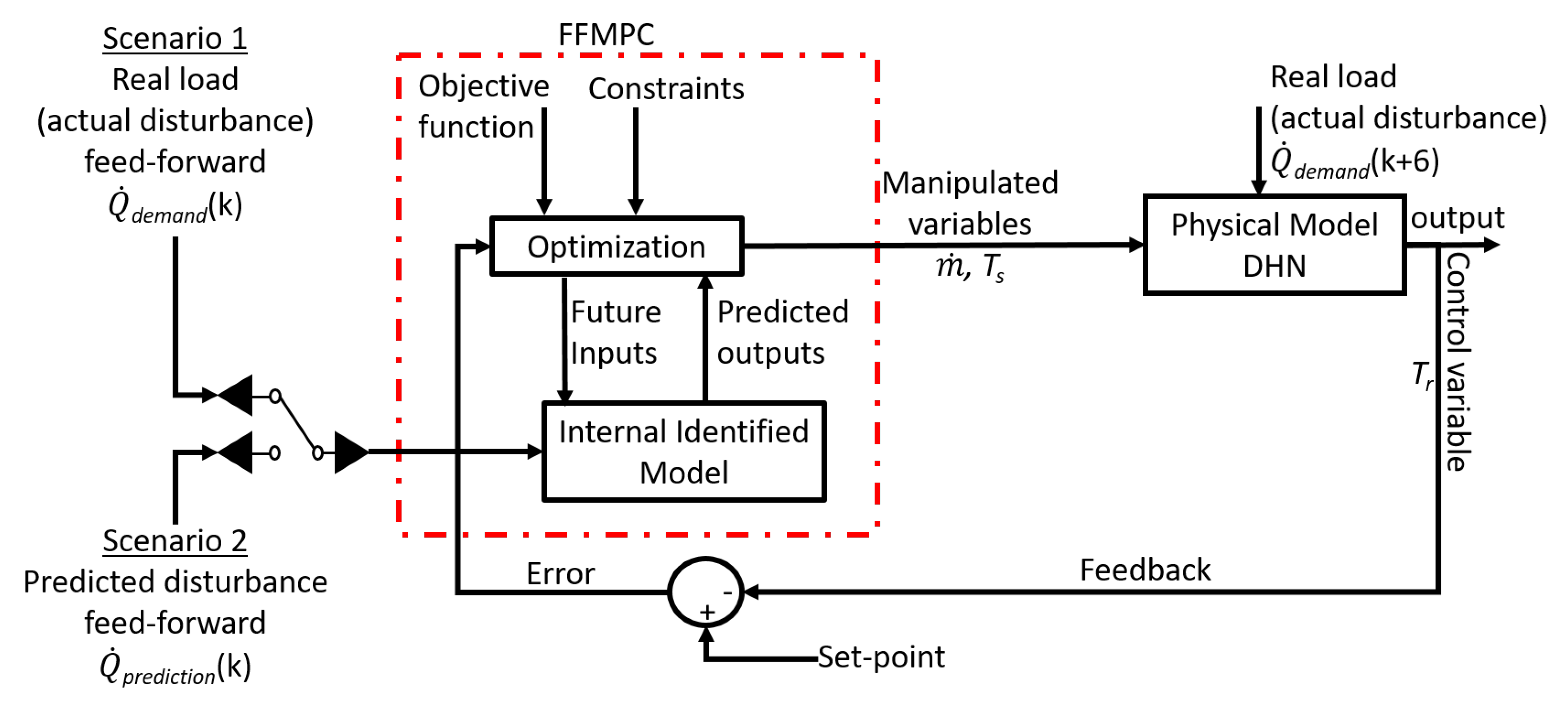

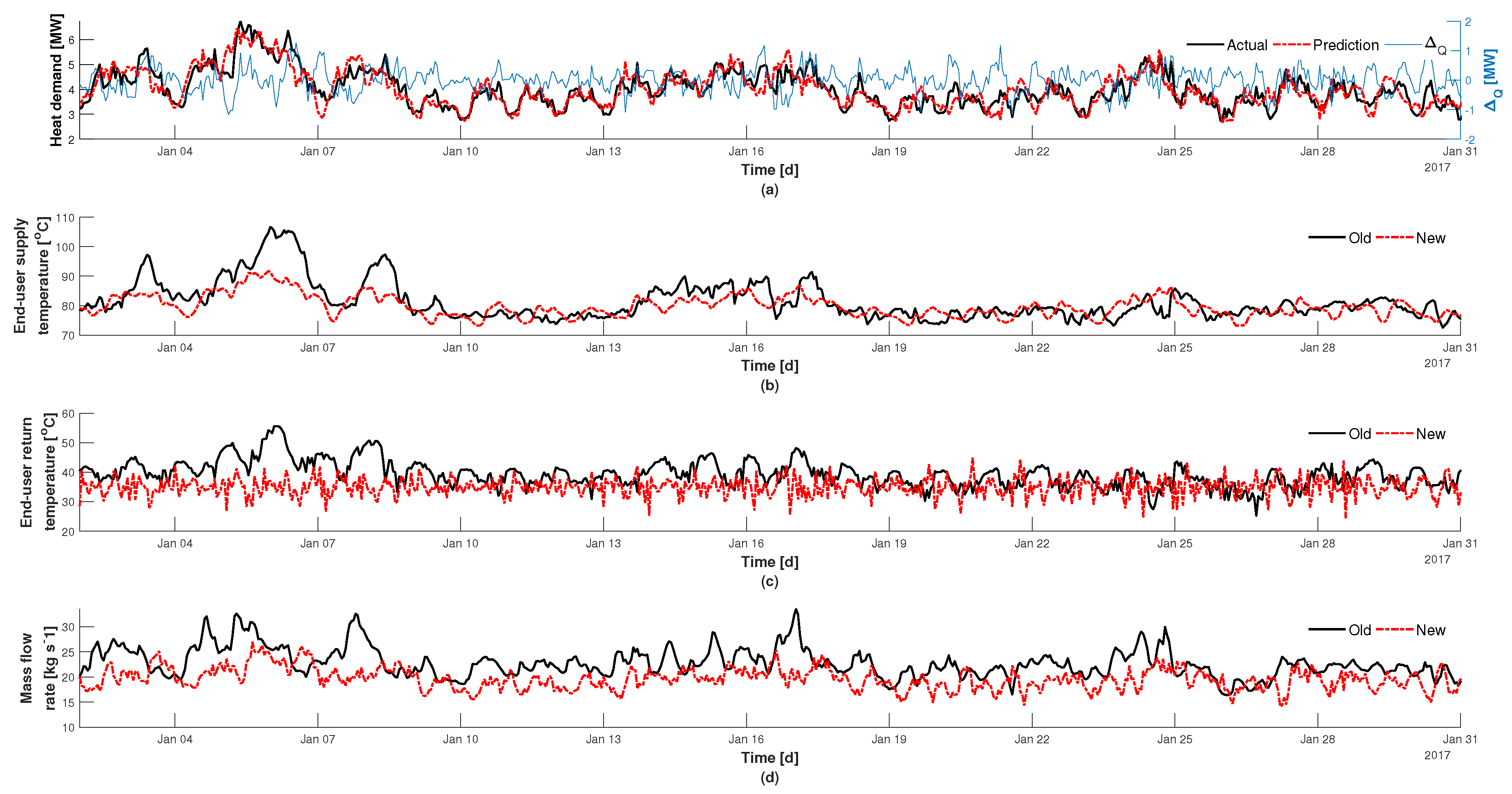
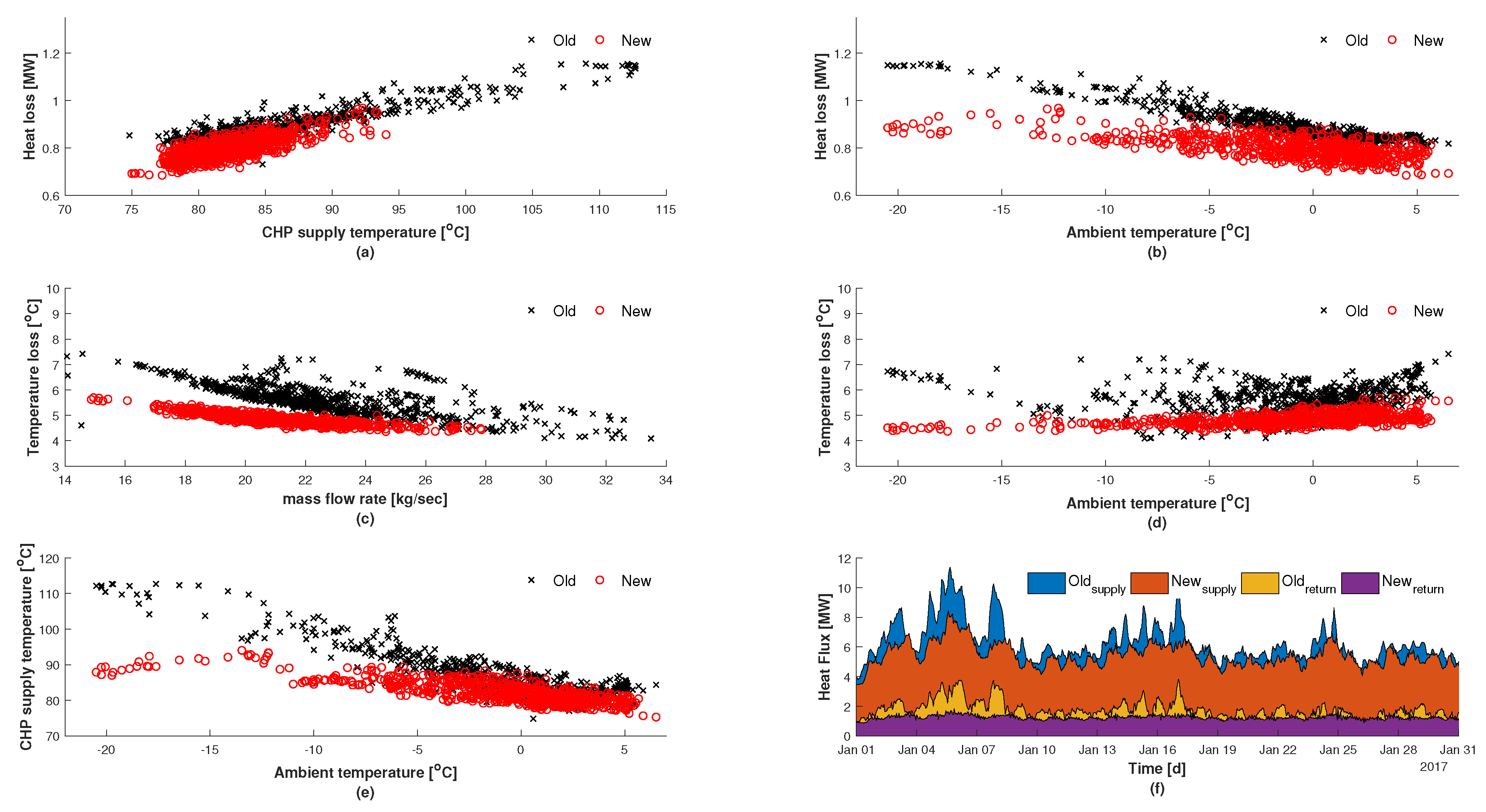
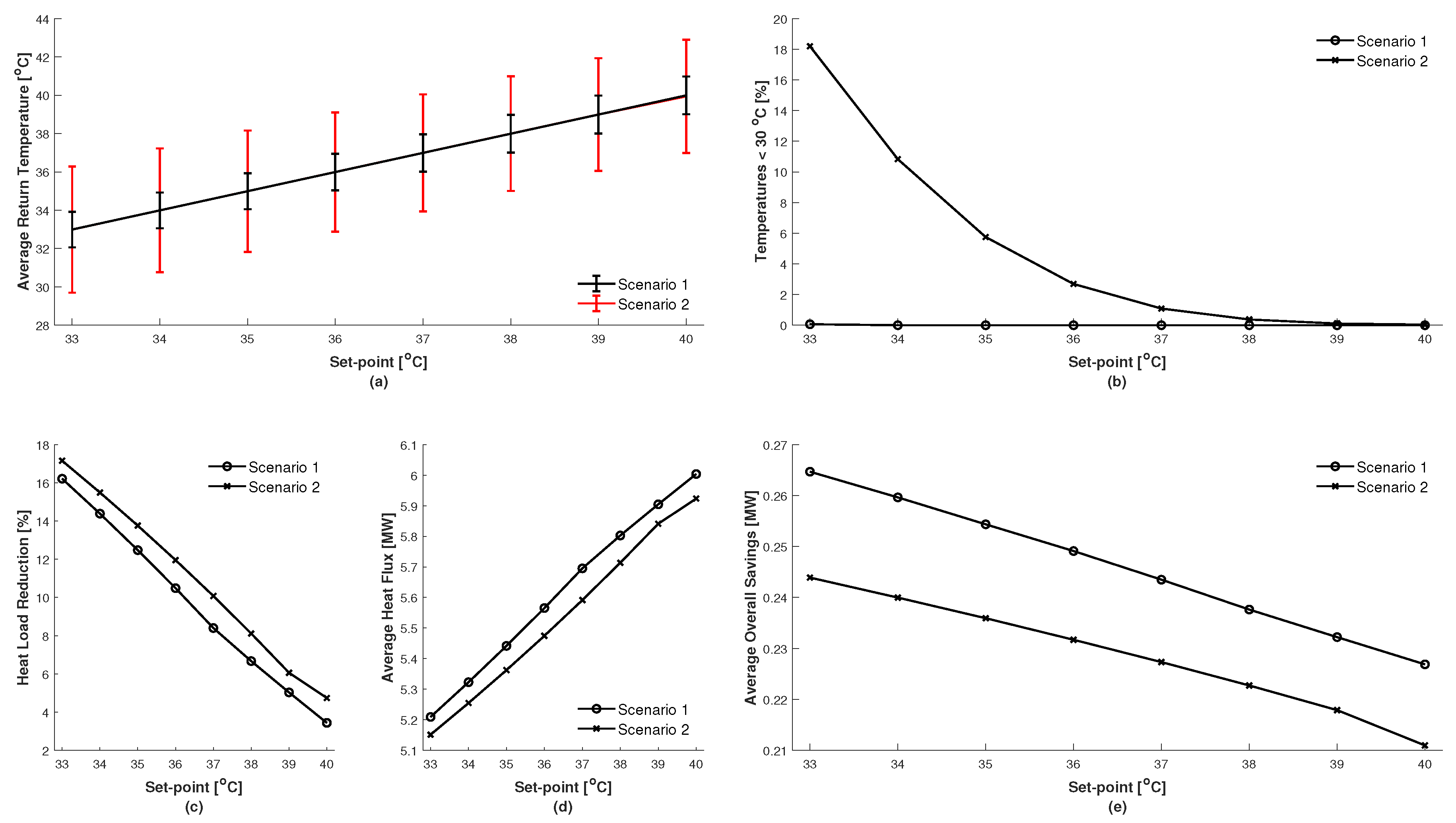
| Historic | Scenario 1 | Scenario 2 | ||||
|---|---|---|---|---|---|---|
| Supply | Return | Supply | Return | Supply | Return | |
| Temp. avg. ( ) | 86 | 39.2 | 82.3 | 35 | 86 | 35 |
| Temp. std. ( ) | 6.6 | 4.4 | 3.1 | 0.9 | 3.7 | 3.1 |
| Temp. loss avg. ( ) | 5.6 | - | 4.8 | - | 5.3 | - |
| mass flow avg. ( ) | 22.6 | - | 21 | - | 19.4 | - |
| mass flow std. ( ) | 3 | - | 2.2 | - | 2.2 | - |
| Heat ( ) | 16.65 × 106 | 47 × 105 | 14.57 × 106 | 33.1 × 105 | 14.36 × 106 | 30.5 × 105 |
| Heat reduced (%) | - | - | 12.5 | 29.6 | 13.7 | 35 |
© 2019 by the authors. Licensee MDPI, Basel, Switzerland. This article is an open access article distributed under the terms and conditions of the Creative Commons Attribution (CC BY) license (http://creativecommons.org/licenses/by/4.0/).
Share and Cite
Zimmerman, N.; Kyprianidis, K.; Lindberg, C.-F. Achieving Lower District Heating Network Temperatures Using Feed-Forward MPC. Materials 2019, 12, 2465. https://doi.org/10.3390/ma12152465
Zimmerman N, Kyprianidis K, Lindberg C-F. Achieving Lower District Heating Network Temperatures Using Feed-Forward MPC. Materials. 2019; 12(15):2465. https://doi.org/10.3390/ma12152465
Chicago/Turabian StyleZimmerman, Nathan, Konstantinos Kyprianidis, and Carl-Fredrik Lindberg. 2019. "Achieving Lower District Heating Network Temperatures Using Feed-Forward MPC" Materials 12, no. 15: 2465. https://doi.org/10.3390/ma12152465




